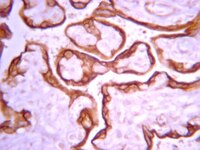05-1106 Sigma-AldrichAnti-IGF-IR Antibody, β-subunit, clone 1-2
Anti-IGF-IR Antibody, β-subunit, clone 1-2 is an antibody against IGF-IR for use in WB, IH(P).
More>> Anti-IGF-IR Antibody, β-subunit, clone 1-2 is an antibody against IGF-IR for use in WB, IH(P). Less<<Recommended Products
Overview
| Replacement Information | |
|---|---|
| Replacement Information | 05-1106 is a recommended replacement for MAB1123 |
Key Spec Table
| Species Reactivity | Key Applications | Host | Format | Antibody Type |
|---|---|---|---|---|
| H, R, M | WB, IH(P) | M | Affinity Purified | Monoclonal Antibody |
| References |
|---|
| Product Information | |
|---|---|
| Format | Affinity Purified |
| Control |
|
| Presentation | Purified mouse monoclonal IgG2b in 10mM PBS, pH 7.4, with 0.2% BSA and 0.09% sodium azide. |
| Quality Level | MQ100 |
| Physicochemical Information |
|---|
| Dimensions |
|---|
| Materials Information |
|---|
| Toxicological Information |
|---|
| Safety Information according to GHS |
|---|
| Safety Information |
|---|
| Storage and Shipping Information | |
|---|---|
| Storage Conditions | Stable at 2-8°C in undiluted aliquots for up to 1 year from date of receipt. |
| Packaging Information | |
|---|---|
| Material Size | 100 µg |
| Transport Information |
|---|
| Supplemental Information |
|---|
| Specifications |
|---|
| Global Trade Item Number | |
|---|---|
| Catalogue Number | GTIN |
| 05-1106 | 04053252404191 |
Documentation
Anti-IGF-IR Antibody, β-subunit, clone 1-2 SDS
| Title |
|---|
Anti-IGF-IR Antibody, β-subunit, clone 1-2 Certificates of Analysis
| Title | Lot Number |
|---|---|
| Anti-IGF-1R, -subunit, clone 1-2 - 1978007 | 1978007 |
| Anti-IGF-1R, -subunit, clone 1-2 - 2001253 | 2001253 |
| Anti-IGF-1R, -subunit, clone 1-2 - 2070000 | 2070000 |
| Anti-IGF-1R, -subunit, clone 1-2 - 2154090 | 2154090 |
| Anti-IGF-1R, -subunit, clone 1-2 - 2297319 | 2297319 |
| Anti-IGF-1R, -subunit, clone 1-2 - NG1576252 | NG1576252 |
| Anti-IGF-1R, -subunit, clone 1-2 - NG1576253 | NG1576253 |
| Anti-IGF-1R, -subunit, clone 1-2 - NG1640808 | NG1640808 |
| Anti-IGF-1R, -subunit, clone 1-2 - NG1800808 | NG1800808 |
| Anti-IGF-1R, -subunit, clone 1-2 - NG1853757 | NG1853757 |









